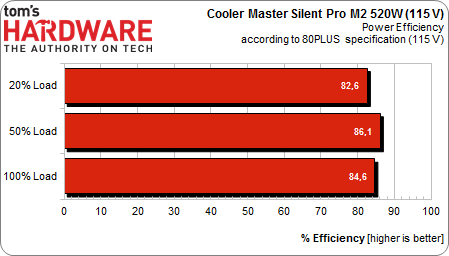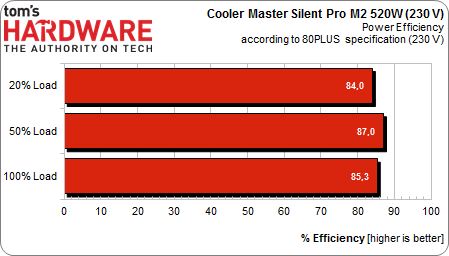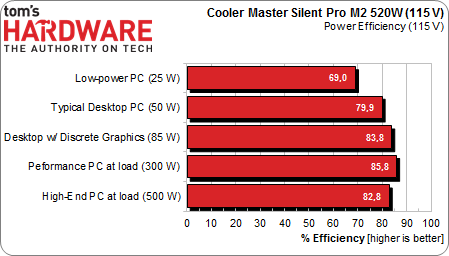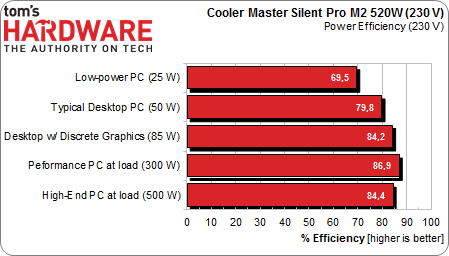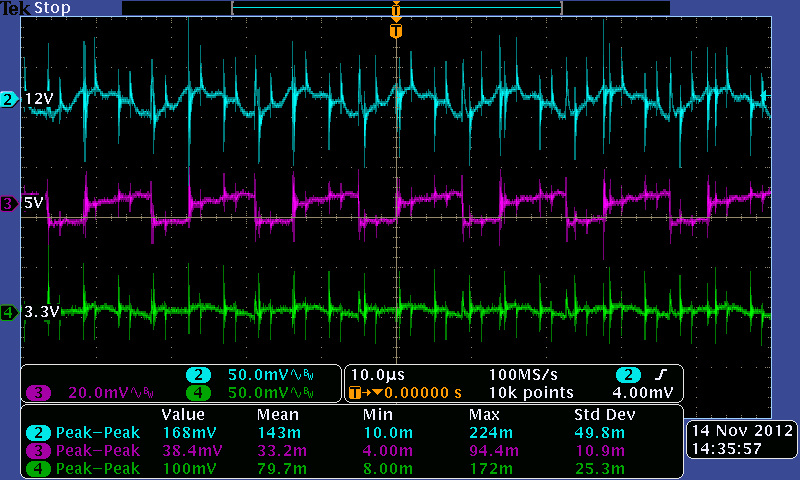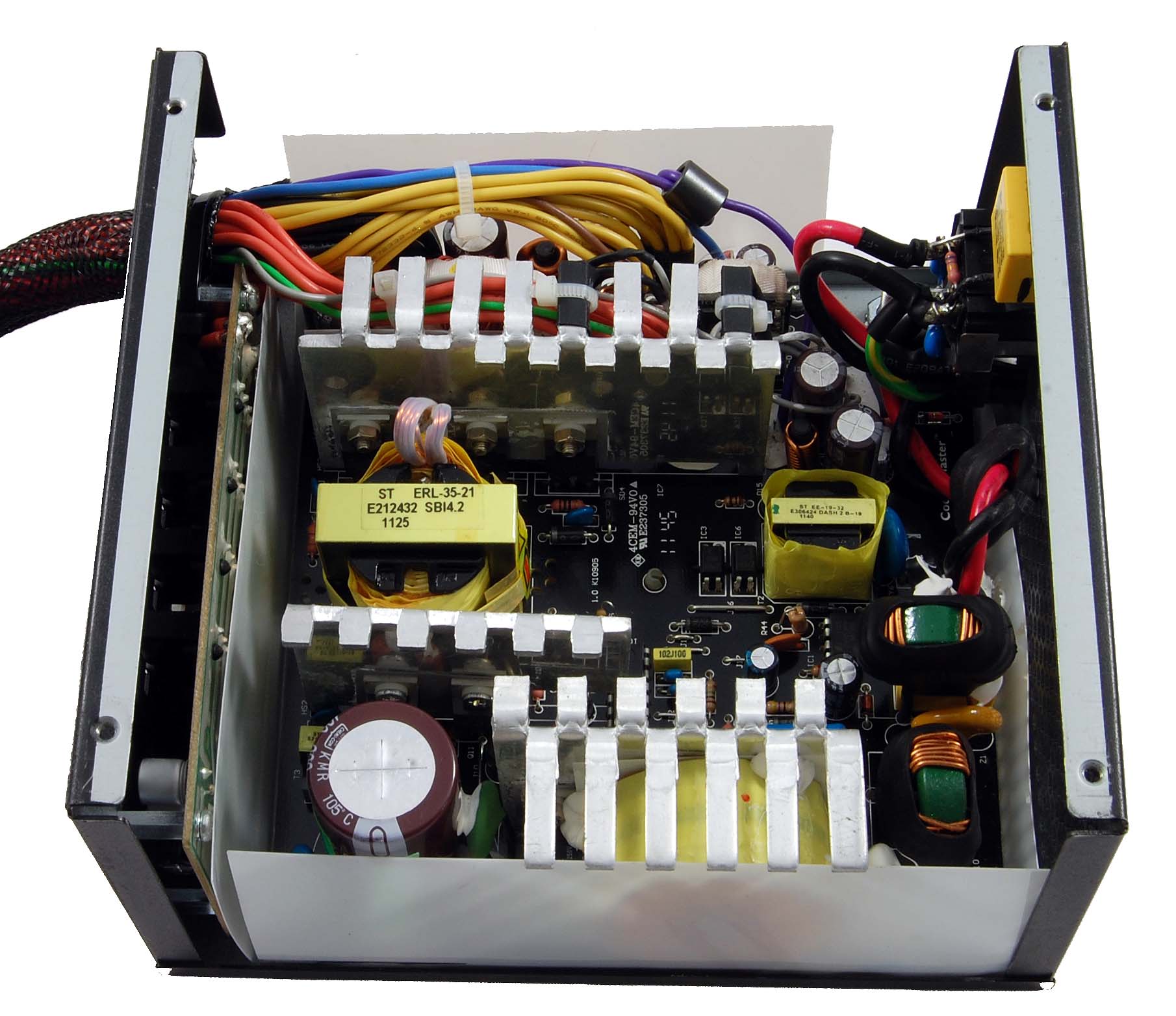Part 2: Four Cheap 80 PLUS Bronze Power Supplies, Reviewed
Ready for part two of our low-cost power supply round-up? Here are four more products, including Seasonic's SSR-360GP, which is 80 PLUS Gold-certified. Is this little 360 W PSU the bargain of the century, or is its Gold label simply pyrite?
Cooler Master Silent Pro M2 520W: Measurements
Efficiency According to the 80 PLUS Spec
Efficiency by Load
Like all of the power supplies in yesterday's and today's stories, Cooler Master's Silent Pro M2 exhibits short spikes on the supply rails. Only the new higher-quality oscilloscope probes are able to pick them up. On the 12 and 3.3 V rails, these spikes exceed the maximums specified by the ATX spec. However, since every sample demonstrate the same phenomenon, we're not counting this against any of them.
When the brief spikes are not taken into account, this 520 W power supply easily complies with the ATX spec. It's also 80 PLUS Bronze-compliant. At 50% and 100% load, it even offers significant efficiency reserves. While standby power draw and inrush current are average, the Silent Pro M2's hold-up time is best-in-class at 27 ms. We have no complaints about the sound level of the Cooler Master PSU, either. It lands around 31 dB(A), regardless of whether we apply 40 W or 200 W of load.
A Close Look at the PCB
The 135 mm fan inside Cooler Master's Silent Pro M2 is made by Young Lin Tech, model DFS132512M and sports a liquid bearing. The large cooling fins almost have a retro look, since most modern PSUs have smaller fins, enabled by better efficiency and less heat output. The input filter has all necessary components, in this case two X capacitors, two Y capacitors, two choke coils, and a MOV. While the large capacitors are made in Japan by Matsushita and Panasonic, the smaller ones are manufactured by Taiwan-based Teapo. We liked the soldering quality.
Get Tom's Hardware's best news and in-depth reviews, straight to your inbox.
Current page: Cooler Master Silent Pro M2 520W: Measurements
Prev Page Cooler Master Silent Pro M2 520W Next Page Corsair CX500-
pepsimtl Please, if you could say , if the power supply is compatible with Haswell .I think this is very important .Reply -
jeffunit I am not sure why you think that a 40w bulb is purely resistive. Almost all bulb filaments are coiled, which makes them inductive. For example, http://www.donsbulbs.com/cgi-bin/r/b.pl/h4652|12.8v|40w|60w~usa.html shows a 12v 40w bulb filament, which is coiled.Reply
Perhaps you should measure the inductance of your bulbs, rather than just stating they are purely resistive. -
vertexx A couple different PSUs for different applications. I use the Corsair CX 430 & 500 for budget gaming builds, and just this week I ordered the Seasonic for the first time for a home server build. Nice to see those choices validated.Reply
Thanks guys, nice article! -
Someone Somewhere ReplyIn spite of its low price, no important components fall victim to cost cutting.
In the CX500. I think Samxon caps count as cost cutting. -
flong777 I have recommended the CX500 many times to budget builders and now I feel better about it. It is the clear winner. Funny TH says it is loud but it was nearly identical to the CM 520 on their chart in DB noise.Reply
On sale you can pick up the CX500 for $40 which is about as cheap as you will ever find any PSU. If you compare how well that Corsair backs its products, there really is no comparison - Corsair is the only choice.
As far as the Seasonic 360, why on earth would you buy a 360W PSU? I just don't see the point. While I can justify a 500W PSU to a budget builder, I really cannot comprehend recommending a 360W PSU to anyone. I feel cautious with a low wattage 500W PSU. All of these PSUs will run hot and loud if they are stressed and so moving up to a 650W or even an 850W PSU really is not that more expensive.
I got the gold rated 850W Corsair HX 850 for $144.00 on sale. I can not even begin to describe how excellent this PSU is. It runs as something around 92% efficiency under load and I have never hear the fan even come on (it may be that low fan is inaudible). It comes with a 7-year warranty and is modular.
If you are not strapped with a low budget, moving up is the only way to go. If you are, the CX 500 is a good choice.
-
vertexx Reply
I just ordered the Seasonic for a home server build. The higher efficiency is a plus since it will be running 24x7. Plus, the system really doesn't need the extra wattage.11443584 said:As far as the Seasonic 360, why on earth would you buy a 360W PSU? I just don't see the point. While I can justify a 500W PSU to a budget builder, I really cannot comprehend recommending a 360W PSU to anyone.
PSUs run more efficiently under load. IMO, the trend has been to overkill on the PSU when it's not really needed. In reality, when you actually add up the max loads of all components a 350-450W PSU is more than enough to run most single GPU gaming builds.
-
vertexx Reply
It's been a while since I've been involved in DC power calculations, but these bulbs are DC bulbs. At DC steady state, what role does inductance play?11443366 said:I am not sure why you think that a 40w bulb is purely resistive. Almost all bulb filaments are coiled, which makes them inductive. For example, http://www.donsbulbs.com/cgi-bin/r/b.pl/h4652|12.8v|40w|60w~usa.html shows a 12v 40w bulb filament, which is coiled.
Perhaps you should measure the inductance of your bulbs, rather than just stating they are purely resistive.
